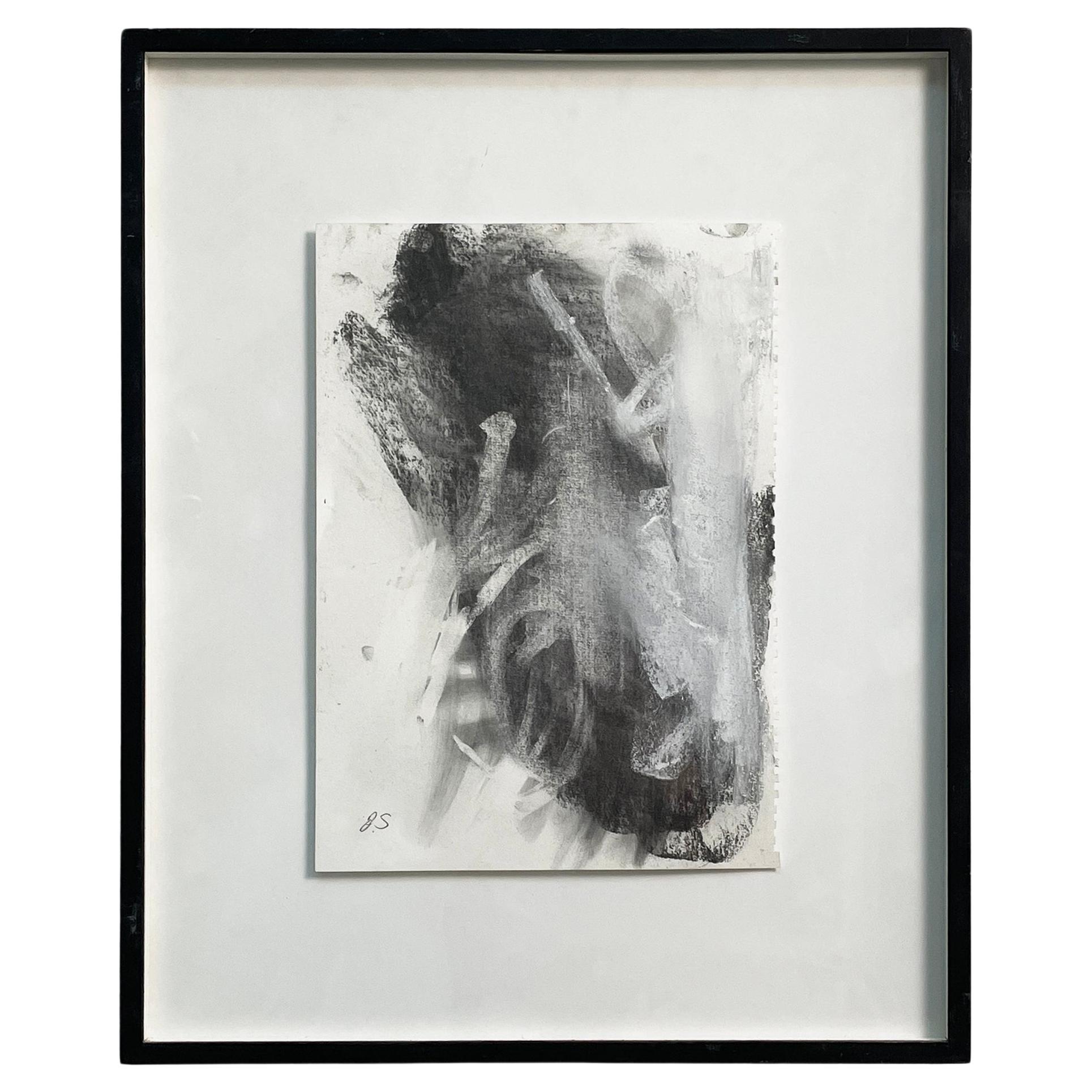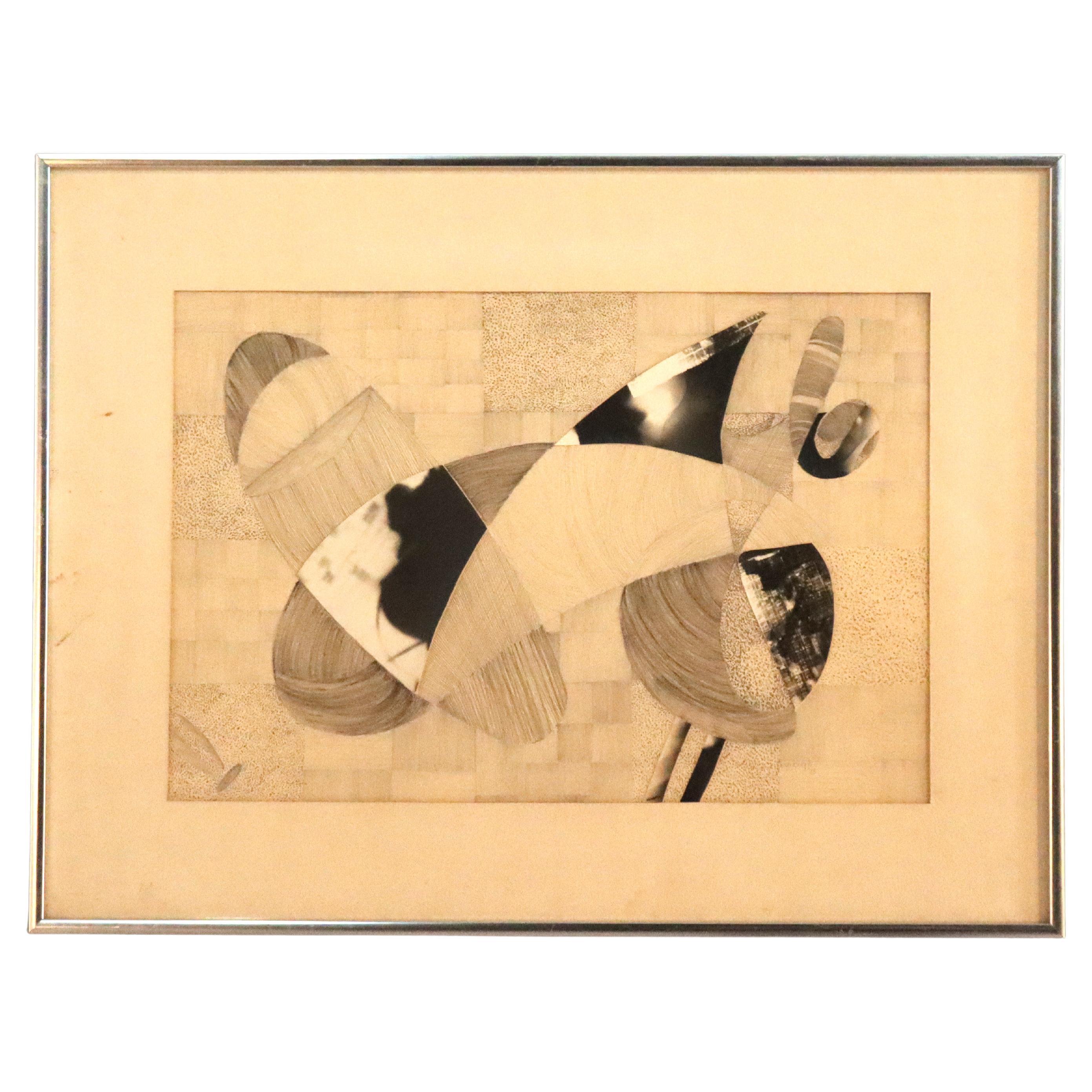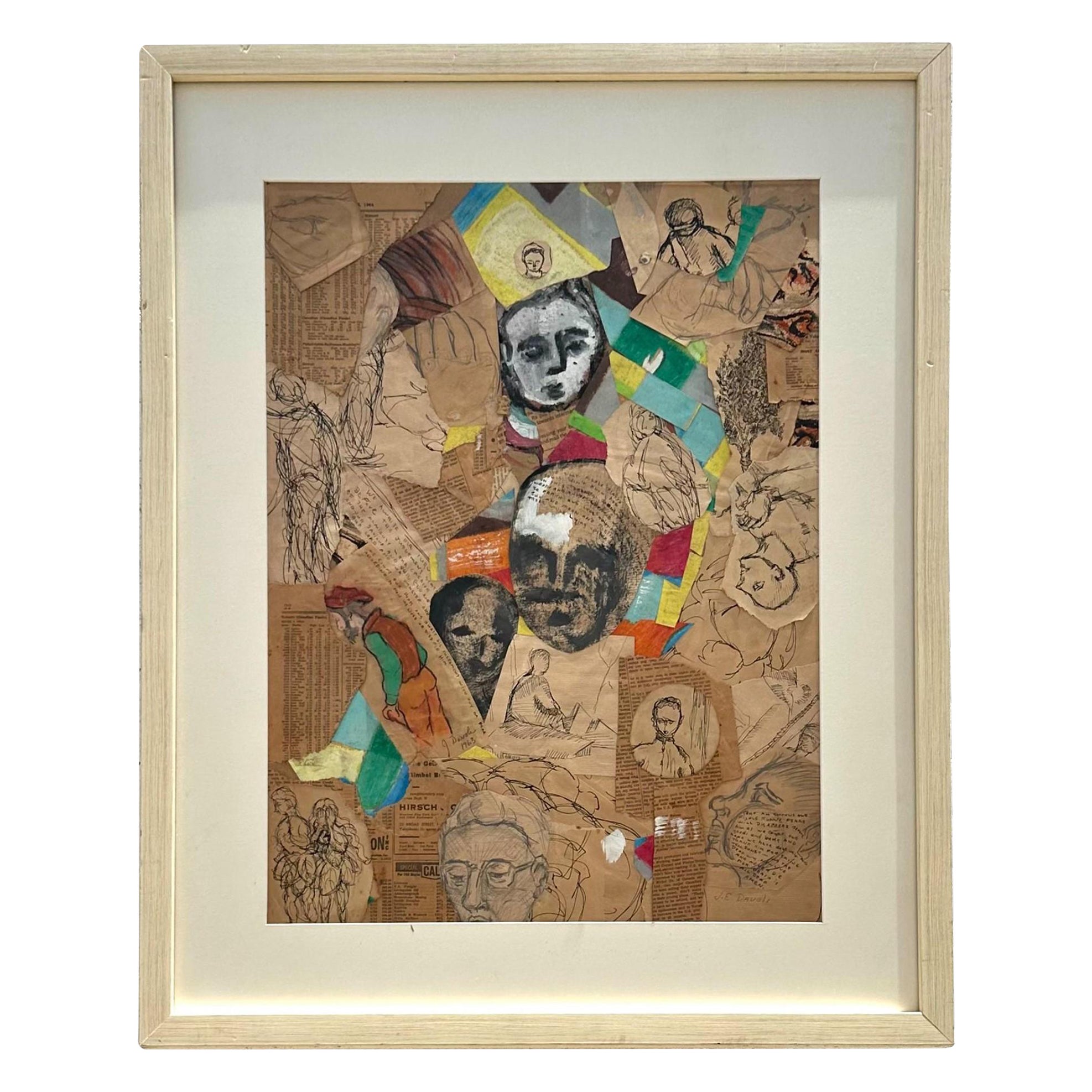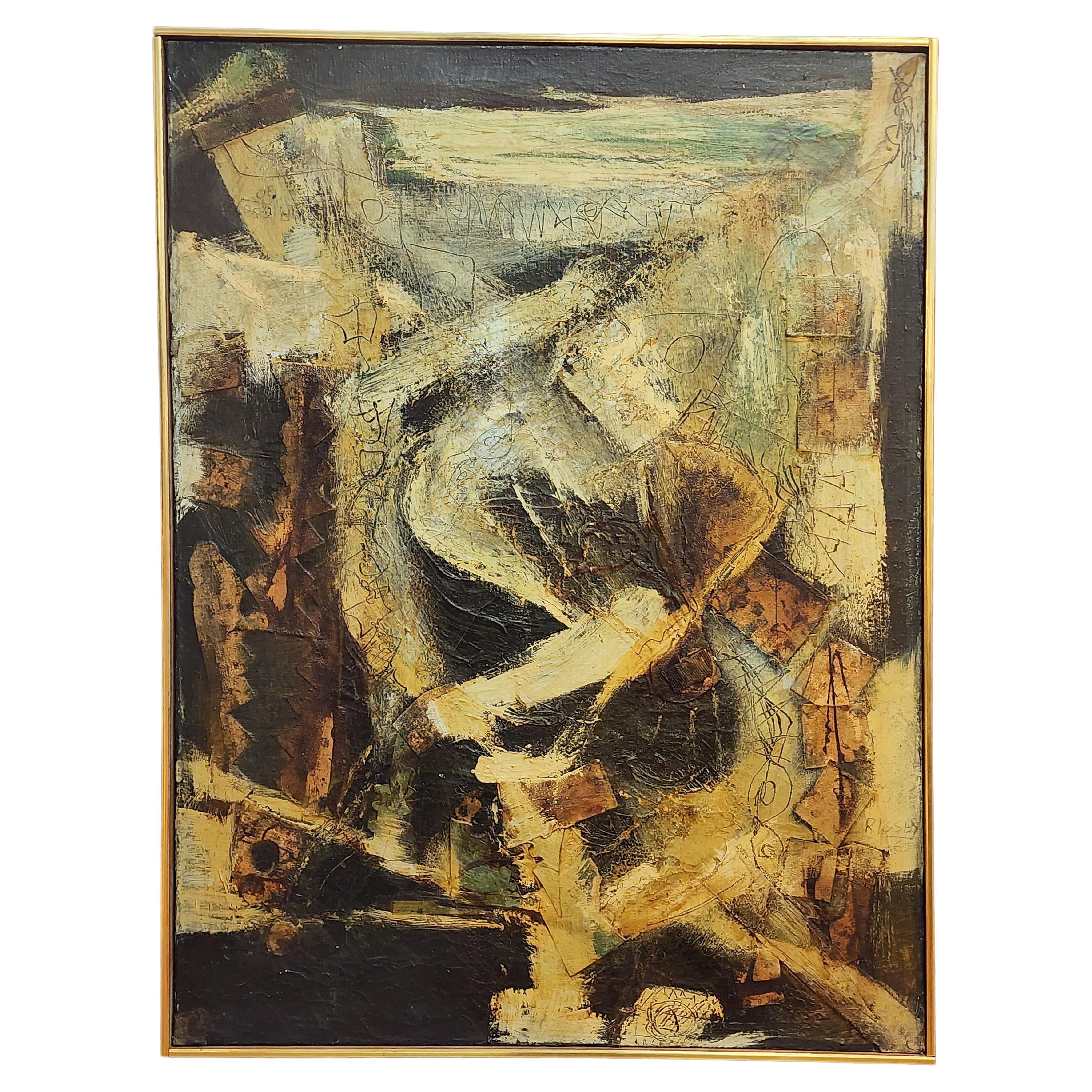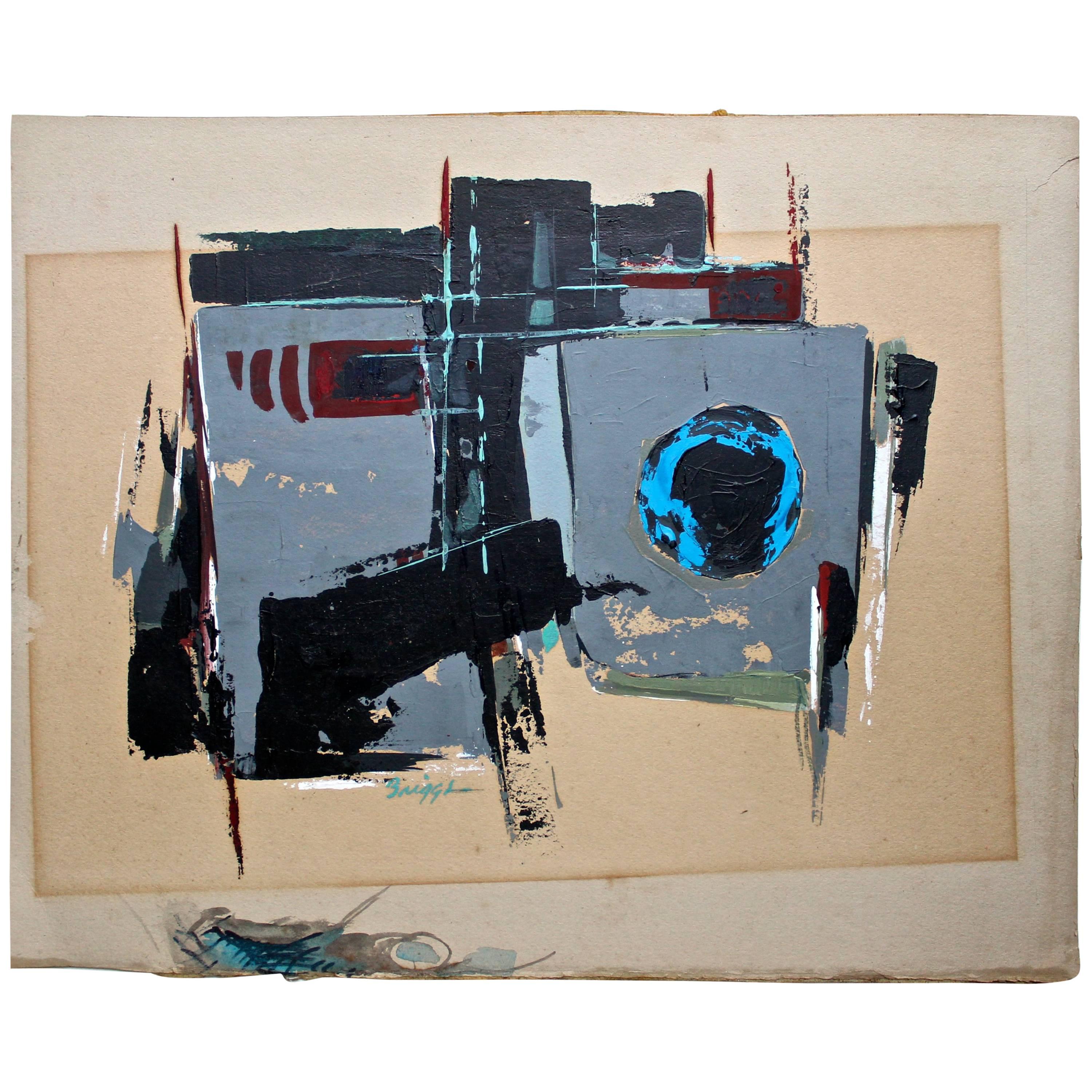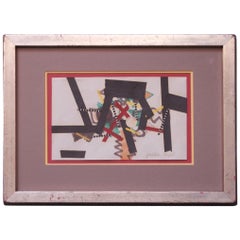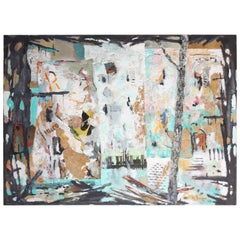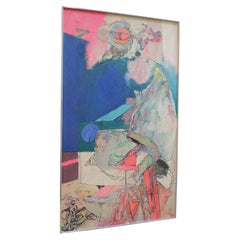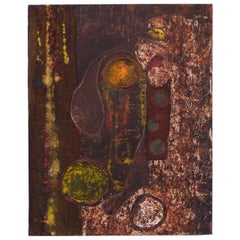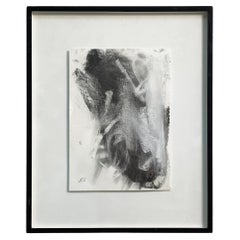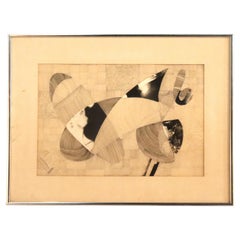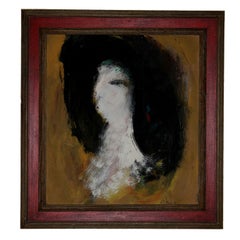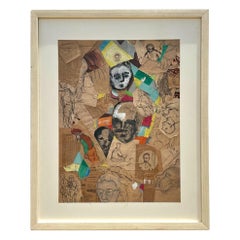Items Similar to Abstract Expressionist Mixed Media by Burt Hasen, 1961
Want more images or videos?
Request additional images or videos from the seller
1 of 9
Abstract Expressionist Mixed Media by Burt Hasen, 1961
$2,800
£2,171.04
€2,463.45
CA$4,013.68
A$4,364.31
CHF 2,299.56
MX$53,013.64
NOK 28,910.15
SEK 27,100.93
DKK 18,486.03
About the Item
Burton Stanley Hasen (New York City, 1921 - 2007) abstract expressionist mixed media (watercolor and ink) on paper. A New York native, Hasen relocated to Paris to study art at the Académie de la Grande-Chaumière after serving in WWII. He took elements of his war experience (namely, the study of aerial maps) and applied them to his work.
Anita Shapolsky critiqued Hasen’s work by likening them to pictorial fables in flux, consistently concerned with the metamorphosis that occurs between the shifting layers of reality and the subconscious.
This 1961 work employs all of these elements. There are distinct "sections" mapped out as parts of a whole that collectively tell a story. Hasen wanted each work to be a projection of himself into the cosmic universe, and this example illustrates the fantastical story in the form of a stream of consciousness narrative. A complex work from an undervalued artist.
Artist signed, dated, and dedicated "with great friendship."
1995-2000 - Professor at the School of Visual Arts
1994 - Elected to the National Academy of Design
2000 - Winner of the art award of the American Academy of Arts and Letters
2003 - Retrospective exhibition Southeast Missouri Regional Museum
Selected Collections:
Smithsonian American Art Museum, Washington D.C.
Ro Gallery, NY
Anita Shapolsky Gallery, NY
Susan Teller Gallery, NY
- Creator:Burt Hasen (Artist)
- Dimensions:Height: 19.25 in (48.9 cm)Width: 25 in (63.5 cm)Depth: 1.5 in (3.81 cm)
- Materials and Techniques:
- Place of Origin:
- Period:
- Date of Manufacture:1961
- Condition:
- Seller Location:Brooklyn, NY
- Reference Number:1stDibs: LU1444219076842
About the Seller
5.0
Platinum Seller
Premium sellers with a 4.7+ rating and 24-hour response times
Established in 2007
1stDibs seller since 2015
691 sales on 1stDibs
Typical response time: <1 hour
- ShippingRetrieving quote...Shipping from: Brooklyn, NY
- Return Policy
Authenticity Guarantee
In the unlikely event there’s an issue with an item’s authenticity, contact us within 1 year for a full refund. DetailsMoney-Back Guarantee
If your item is not as described, is damaged in transit, or does not arrive, contact us within 7 days for a full refund. Details24-Hour Cancellation
You have a 24-hour grace period in which to reconsider your purchase, with no questions asked.Vetted Professional Sellers
Our world-class sellers must adhere to strict standards for service and quality, maintaining the integrity of our listings.Price-Match Guarantee
If you find that a seller listed the same item for a lower price elsewhere, we’ll match it.Trusted Global Delivery
Our best-in-class carrier network provides specialized shipping options worldwide, including custom delivery.More From This Seller
View AllMixed Media on Paper by Giuseppe Napoli
By Giuseppe Napoli
Located in Brooklyn, NY
Giuseppe Napoli (1929 - 1967) mixed media on paper (collage / watercolor). An integral part of the 1950s - '60s Greenwich Village artist community and New York School, Napoli was an...
Category
Vintage 1960s American Post-Modern Paintings
Materials
Paint, Paper
Ralph de Burgos Mixed-Media Abstract Collage
By Ralph de Burgos
Located in Brooklyn, NY
Ralph de Burgos (b. Shanghai, China 1906 d. Washington DC, US 1979) mixed-media collage and oil abstract on paper, circa early 1960s.
Burgos was known largely as a painter, with a l...
Category
Vintage 1960s American Mid-Century Modern Paintings
Materials
Paint, Paper
Mid 20th Century American Surrealist Oil on Canvas by Robert Cowan
Located in Brooklyn, NY
Surrealist Oil on Canvas signed 'Bob Cowan, 1968."
Visually appealing with attractive colors incorporated.
Framed dimensions: H: 48.25" x L: 29.25" x D: 1.5"
Category
Vintage 1960s American Mid-Century Modern Paintings
Materials
Canvas, Paint
1974 Mixed-Media Acrylic and Raffia Abstract on Canvas Signed Rohan
Located in Brooklyn, NY
Mixed-media acrylic with raffia and twine signed 'Rohan '74.' Impressive in composition and scale (Measures: H 45.75" x L 36") incorporating various textures, colors, and shapes. Alt...
Category
Vintage 1970s American Mid-Century Modern Paintings
Materials
Raffia, Twine, Acrylic
Parker Panttila Surrealist Study Watercolor on Board
Located in Brooklyn, NY
Parker Panttila (Brooklyn, New York 1924-2002) pen and watercolor on board.
Surrealist in style, incorporating both macabre and comedic sensibilities....
Category
Vintage 1950s American Paintings
Materials
Paint
Bessie Boris "Intersection" Oil and Mixed Media on Paper
Located in Brooklyn, NY
Bessie Boris (Johnstown, PA b. 1917, d. 1993) oil, watercolor, and pastel on paper entitled "Intersection" (1969).
Boris placed great emphasis on color and psychologically charged di...
Category
Vintage 1960s American Mid-Century Modern Paintings
Materials
Paint
You May Also Like
Italian modern Mixed media abstract drawing on paper, 1950s-1990s
Located in MIlano, IT
Italian modern Mixed media abstract drawing on paper, 1950s-1990s
Drawing on paper with black charcoal and white oil pastel. The subject of ...
Category
Late 20th Century Italian Modern Paintings
Materials
Wood, Paper
Abstract Impressionist Mixed Media Drawing by Lynough, Framed, C1975
Located in Big Flats, NY
Abstract Impressionist Mixed Media Drawing by Lynough, Framed, C1975.
18 1/4" x 24 1/4" x 7/8".
An abstract impressionist mixed media drawing signed by Lynough, created around ...
Category
Mid-20th Century Paintings
Materials
Paper
$360 Sale Price
20% Off
Abstract Mixed-Media on Board Attributed to Peter Brandes, 1966
By Peter Brandes
Located in Palm Springs, CA
A very unusual abstract portrait the we believe to be the work of the Danish artist Peter Brandes. It is signed Brandes 66 and it is very much in his sty...
Category
Vintage 1960s Danish Paintings
Vintage Boho Abstract Mixed Media Sketches on Paper
Located in West Palm Beach, FL
A fabulous vintage mixed media collage on paper. A collection of the artist sketches assembled into a collage and then painted over. Acquired from a Mi...
Category
Late 20th Century North American Paintings
Materials
Glass, Wood, Paint, Paper
John David Rigsby Abstract Mixed Media on Canvas, American 1960
Located in Hudson, NY
A handsome and sophisticated mixed media on canvas by American artist John Rigsby. Found in a original state of preservation. His works are few and far between.
The following biography was submitted by John David Rigsby, Jr., son of the artist. The author is Lisa Rigsby Peterson, daughter of the artist, and owner of the copyright of the biography.
John David Rigsby was born on October 10, 1934, the seventh child of an Alabama Depression-era sharecropper's son. He and his family moved frequently, from one one-room structure to another, often with no running water, no plumbing, no heat but the stove. His father was killed in a car accident when Rigsby was just 9 years old. Life for the remaining eight family members proved tumultuous and difficult -- food wasn't plentiful, nor money. The family moved from place to place, following work -- Rigsby attended 30 different schools before graduating from high school. Despite living in poverty, Rigsby demonstrated academic and artistic aptitude at a young age. Two oil paintings on covers ripped off of old books that he painted when he was eight years old show the promise of an imaginative and gifted eye.
Rigsby was drafted by the U.S. Army in 1953. As he later wrote, "When basic training at Fort Jackson, South Carolina, was over, I was told to go out and find a job. Jasper Johns was painting visual aids for the 28th Regimental Headquarters. He suggested the Band Training Unit." Rigsby played the clarinet in that unit, and after 2 years of service, he enrolled at the University of Alabama on the G.I. Bill to study art. After just two years, he left school and followed his mentor (and one of the greatest and longest-lasting influences on his art), Japanese artist and U of A art instructor Tatsu Heima, to New York City. Heima introduced him to Isamu Noguchi and suggested that Rigsby work as Noguchi's assistant. Instead, Rigsby chose a job as a guard at the Metropolitan Museum of Art, since "the notion of seeing all of that art appealed more to me than the boring task of studio assistant." The opportunity was a rich one for Rigsby. He had a chance to study the masters, and cited Rembrandt with his simplicity and elegance as another of the most important influences on his work.
In the years between 1957 and 1963, when Rigsby eventually earned his BFA in sculpture, the artist traveled back and forth between New York and Tuscaloosa, alternating study with forays into the fertile New York art scene. Rigsby exhibited some of his early sculpture work in 1958 at a small New York gallery, which was also exhibiting the work of Willem and Elaine de Kooning and Theodore Stamos. Shortly thereafter, searching for an educational venue closer to New York City, Rigsby visited New Haven, Connecticut, and spent an afternoon speaking with Josef Albers at Yale. Albers agreed to accept Rigsby into the Yale program on the condition that he take freshman drawing all over again. A brilliant opportunity, but, in Rigsby's words, "When it was time to register, I was hitchhiking back to Alabama, looking for food and shelter."
Rigsby had his first one-man show at the University of Alabama in 1959. A visiting critic from New York, J.F. Goosen, reviewed the show and wrote "here is a talent which produces art because that is the thing for a gifted person to do. In his effortless ease of conception and execution, he has already achieved a goal that eludes many artists for a lifetime." Finally, in 1963, Rigsby received his degree in sculpture, dissolved a short-lived marriage, visited his family, packed up his car and headed permanently for New York. That year, his work was included in a group show at the Delgado Museum in New Orleans - which led to a one-man exhibit at the Delgado in 1964. During 1964, Rigsby took drawing classes at Columbia University, and worked at the General Post Office at night. He met his future wife, Linda Palmieri, and married. In 1965, his daughter Lisa was born, followed in 1966 by the birth of his son, John David Jr.
In 1966, Rigsby had a successful one-man show at the Pietrantonio Gallery in New York. Shortly thereafter, he and the family moved to Tunis, Tunisia at the suggestion of a colleague, who urged him to "come paint by the light of Klee." Rigsby worked for the United States Information Agency as a teacher, and he spent the next year and a half painting over ninety paintings inspired by the smells, light, and Phoenician and Roman art surrounding him. He also executed a number of character and landscape drawings, capturing the Tunisian way of life. During his time in Tunisia, Rigsby's work was shown there in two major exhibits.
Upon the family's return to the U.S. in 1968, Rigsby once again exhibited at the Pietrantonio Gallery. Later that year, Rigsby enrolled in Southern Connecticut State College's Urban Studies program, earning a master's degree in 1970. During his time at SCSU, Rigsby worked as the city of Bridgeport's Curator of Exhibits, driving a mobile art gallery from schools to neighborhood fairs and housing projects. After completing his degree, Rigsby had an exhibit at the Telfair Museum in Savannah, Georgia. This exhibit caught the attention of a member of the search committee looking to hire an artist for a newly-developed program in neighboring South Carolina.
In 1970, Rigsby was selected as the first Artist-in-Residence in the state of South Carolina for the National Endowment for the Arts Artists in Schools program. His work with the newly-integrated students at Beaufort (SC) High School over the term of his residency precluded substantial work on his own art. He did, however, set up a studio in downtown Beaufort, and was able to create a modest number of paintings, which were included in exhibits at the Columbia Museum in South Carolina in 1971 and Yale University in 1973.
At the end of his residency in 1974, Rigsby was named the National Visual Arts Coordinator of the Artists in Schools program for the NEA, a post he held for two years. In this position, Rigsby traveled the country, reviewing grant applications, meeting with state leaders in government, education and the arts to promote program concepts and explore local opportunities. The message he repeated over and over again echoed that of one of the other major influences on Rigsby as an artist - Ruth Asawa Lanier, whose words taught him that all of the work that the artist does is the artist's work, not simply the paintings he creates. In his capacity as National Coordinator, as well as many times in the future, Rigsby stressed that artists function in the same way as any other person in society, and deserved the same respect and place for their work as did all other professions. After two years traveling the country, Rigsby was ready for a change, saying "for the first time in my adult life, there was not a body of paintings to show for the years put into my work."
In 1976, a summer retreat to the mountain community of Central City, Colorado, led to a permanent relocation. Eventually settling in the small town of Evergreen, Rigsby followed his own advice about artists becoming actively involved in their communities, and he established the Evergreen Visual Arts Center. The Center provided working space for artists, classes for adults and children, and, most importantly, a place for Rigsby to create his own work. Buoyed by the opportunity to concentrate once again on his art, and inspired by his new surroundings, Rigsby entered an extremely prolific period in his career. In 1977, he organized a traveling exhibition of his paintings, which showed at the Kimball Arts Center in Utah, the Kennedy Center in Washington, D.C., and the Arvada Center in Colorado.
1978 brought more exhibits, notably in Aspen and Denver, as Rigsby's work continued. He took an extended trip to visit his mentor, Tatsu Heima, in Japan, where he climbed Mt. Fuji, followed by travels to Tehran, Delhi, and several European countries. He chronicled his impressions from his travels in a small collection of paintings upon his return to the U.S. - the beginning of a practice which would continue through the rest of his life. In 1979, Rigsby's marriage failed, and at the same time he lost the lease to his Evergreen studio to redevelopment plans. In response to the personal chaos around him, Rigsby began a series of what he called "hard-nosed process paintings," the watercolor paintings of dots which marked his work from this period. The paintings gained him an NEA Individual Artist grant in 1980, as well as a Yaddo fellowship in 1981. The polka dot paintings were followed by a series of cupcake-like images, again examining space and color.
During the early 1980s, Rigsby lived in a suite of old dentists' offices in a rundown part of Denver, with a studio in an area that reminded him of the Bowery in New York. In 1984, Rigsby founded the Progreso Gallery in the building where he lived, using the space both to show his own work and also to mount shows of the work of many Colorado artists. The gallery also served as a focal point for Denver's local arts community, hosting weekly discussion groups and classes. In 1984, Rigsby traveled to the Baja Peninsula and then in 1985 to Yugoslavia. After each sojourn, Rigsby returned to create vibrant and explosive paintings based on his experiences, showing them at his Progreso gallery and another alternative gallery in Denver, the Edge Gallery. The economic recession of the mid-eighties hit the art market and Rigsby hard, however, and although he continued to create new works of art, major exhibitions were difficult to come by.
In 1987, Rigsby decided to leave Denver and spent six months in Barcelona, Spain. It was an electrifying trip for him. Rigsby wrote of that time:
"The streets alone are a visual feast, and the additions of museums from Saarinen, Picasso and Miro to 12th century icons produced artistic indigestion. My paintings are always about the way things look and feel. Barcelona was a time machine extending those sensory and emotional concerns back to the Middle Ages. I felt the need to reduce my work to essential elements of color, scale, drawing and format. The [resulting] color studies speak eloquently for themselves, and in doing so, redefine all of the work I've done in the past 35 years of painting."
Rigsby completed over a hundred paintings while in Barcelona - color studies, street portraits of the characters he encountered on a daily basis, and a number of dark landscape paintings. He found time to run with the bulls in Pamplona, and began writing stories about his adventures that were later published.
Upon his return to Denver in 1988, Rigsby continued to explore the alter egos of the color studies - he concentrated on a series of dark paintings, all prominently featuring back. He commented about these black paintings that he " decided it was time to explore the perception of the eye and physical space as defined by low -light conditions…I find these paintings elegant, joyous and light-filled, with no feeling of heaviness at all." In mid-1988, Rigsby moved permanently to Houston, Texas, where he would spend the last five years of his life.
Once in Houston, Rigsby made a discovery that would serve as the inspiration and material for some of the last works of his career. In 1989, he discovered a salvage yard filled with scrap rubber, and he began working on black rubber sculptures, as well as paintings with rubber elements incorporated. He made strong connections in the Houston alternative arts scene, and became a regular contributor and art critic for a local weekly newspaper, The Public News. From 1989 through 1992, he exhibited his sculptures and paintings at Houston's Brent Gallery, Fountainhead Gallery, and Blaffer Gallery. He also produced an installation of his rubber sculptures on the roof of the Diverse Works Gallery in Houston. 1992 also marked Rigsby's return to Denver when he exhibited his sculptures at the Payton-Rule Gallery in Denver, leading to an Absolut Rigsby commission by Carillon Importers.
The 1990s were a tremendous struggle for Rigsby, with financial crises compounded by physical trauma (he accidentally sawed off the top joint of the index finger of his left hand while working in his studio). Although his work was being shown, it wasn't selling, and the tremendous financial pressure he felt weighed heavily upon him. He spent an increasing proportion of his time going to flea markets and garage sales, rehabilitating and repairing the things he bought there, and then re-selling them simply to raise enough money to keep a roof over his head. He had little time to paint or sculpt, the things in life that had always, no matter what the circumstances, brought him joy.
Rigsby's final works were a series of intricate paintings and drawings on used books that he purchased at the flea market. Most of these drawings, which he referred to as sculptural form drawings, were executed on page after page of science texts, music books, and a Korean bible and fill hundreds of pages. Additionally, Rigsby created an exquisite book he titled 28 de los Angeles, in which his twenty-eight simple and elegant drawings of angels resonated with the influence of Rembrandt he had so admired in his early days. In a sense, Rigsby's final works, art created on used books which were the only materials he could afford, brought his work and life full circle from his childhood days. Rigsby's life, though begun and ended in adversity, was nonetheless illuminated and enriched by the irresistible impulse he had to create art and beauty.
John David Rigsby was killed in a one-car accident in Colorado in August, 1993.
Biography from the Archives of askART
Following is a review by Michael Paglia of the artist's July 2004 retrospective at the Denver Museum of Contemporary Art. It was submitted by John Rigsby, Jr., son of the artist.
There's a magnificent retrospective at Denver's Museum of Contemporary Art devoted to the work of the late John David Rigsby, who was a major powerhouse in Colorado's art scene. "Dots, Blobs and Angels" surveys more than forty years' worth of the remarkable artist's paintings and sculptures.
The year 1993 was strange, and by that I mean terrible. Many of the city's galleries closed because of bad economic times, and then the artists started dying. In a matter of a few months, Denver lost three significant artists: Rigsby, experimental photographer Wes Kennedy...
Category
Vintage 1960s American Mid-Century Modern Paintings
Materials
Canvas, Paint
Ernest Briggs Abstract Expressionist Oil on Paper
By Ernest Briggs
Located in Sharon, CT
Small oil by this important 'second generation' Abstract Expressionist painter. Entire sheet is 11.5" x 16", matted area is 9.5" x 14.5".
Category
Mid-20th Century American Modern Paintings
Materials
Paper
More Ways To Browse
Betty Woodward
Robert Harding
1920s Nude Male Drawing
Set Architectural Drawings
18th Century Male Nudes
Fashion Sketches
Howard Barnes
Jacques Azema
Large Architectural Drawing
Leonard Reedy
Robert J Harding
Single Line Drawing
Walter Spies
Yves Saint Laurent Drawing
17th Century Dutch Drawings
Academy Nude Drawings
Academy Nude Male
Anton Pieck
